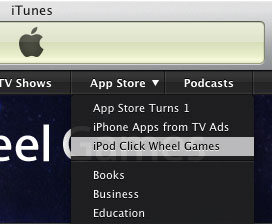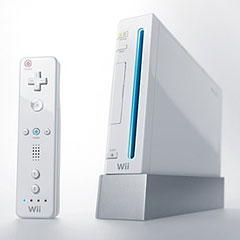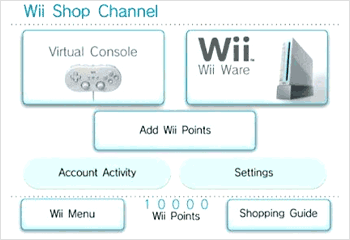Apple and Gaming Today
Apple never had the capacity to be a large-scale distributor of
games until the iPhone and iPod touch were released followed by the
launch of the App Store in July 2008.

The iPhone can be distinguished from
the iPod touch by the green phone icon.
There were games available initially through the
iTunes Store starting in 2006 that will play on the following
"regular" iPods (below from left to right): iPod classic, iPod 5th
generation, and iPod nano 3rd, 4th, and 5th generation.

 These "click wheel" games will not play on the iPod
touch or iPhone, which run games from the App Store. Click wheel games
are still available from the iTunes Store: If you're using iTunes 9,
select the App Store, and then select iPod Click Wheel Games
from the pulldown menu. If you're using iTunes 8, there's an iPod
Games link on the main iTunes Store page.
These "click wheel" games will not play on the iPod
touch or iPhone, which run games from the App Store. Click wheel games
are still available from the iTunes Store: If you're using iTunes 9,
select the App Store, and then select iPod Click Wheel Games
from the pulldown menu. If you're using iTunes 8, there's an iPod
Games link on the main iTunes Store page.
Apple's Big Opportunity
With the release of the iPhone and iPod touch apps, Apple is poised
to become a major player - and possibly the largest distributor in the
video game industry. As Steve Jobs indicated in his latest "Stevenote"
presentation, there are now over 100 million iTunes Store accounts with
credit cards, making the iTunes Store one of the largest online
marketplaces in the world.
With the App Store continuing to grow, along with the availability
of games (6,000+ games now available), there is incredible potential
for Apple to capitalize on a market that has been traditionally held
firmly by the likes of Sony, Nintendo, and, more recently,
Microsoft.
The biggest problem with App Store games is that Apple and the
software developers have made these applications playable only on the
iPod touch and iPhone. These games will not play on your Mac, because
they are designed to work only on iPhone and iPod touch hardware.
If they could, imagine the possibilities....
The Competition's Solutions
Nintendo
Nintendo (the big "N", as we know them in the gaming industry) has
consistently released family friendly content and is very proud of its
Virtual Console and original Wii Ware titles, which are digitally
distributed and stored on the Wii
or an SD Card.


Nintendo Wii (Fall 2006) offers many classics and new content through
Virtual Console and WiiWare downloads.
Unfortunately, these products can't simply be played on a Nintendo
DS. The same holds true with Nintendo's newest product, the DSi, which
has a separate download store.
The Nintendo DSi, released in 2008, has it's own digital content
store. Why couldn't the DSi utilize all Virtual Console games from the
Wii, giving you the freedom to use them where you want? The DSi could
have simply delivered digital versions of the Game Boy, Game Boy Color,
and Game Boy Advance library, along with new content on DSiWare.
Microsoft
Microsoft failed to cross-market the Zune with the Xbox 360, and
they still haven't figured it out. Had they done so, their audience for
the Zune could have included millions of Xbox 360 owners. Instead,
Microsoft continues to insist on another failed attempt to create a
media player to rival the iPod (specifically the iPod touch).
I could go on and on why the iPod touch is a better device, but just
two words sum it up: App Store.
The Zune missed the boat again - It could have been designed to
compete with the PSP and should have been the media player it is with
support for Xbox Live accounts and Xbox Live Arcade games. The Zune
could have been a gamer's dream and could have helped push the Xbox 360
to new heights had it included this feature.
Sony
Sony is the only player in the gaming industry that has gotten it
right. Although the Xbox Live Arcade is superior from an offering of
games thus far, there is no handheld marketed with the Xbox 360 to take
advantage of this feature, compared to how the PS3 and PSP go hand in
hand.
Sony is quickly catching up to Microsoft with the PlayStation Store,
which was initially designed to deliver digital content to the PS3.
When Sony added support for the PSP, it took things to a whole new
level. Now nearly all content from the PlayStation Store (except
specific PS3 or PSP content) can cross back and forth between both
platforms, giving you the flexibility to watch a movie or play certain
games at home or on the go, provided that you own both devices.
If you own a PSP-2000 or later, you can even download a PS1 classic,
a PSP title, various movies, or music, and play them back directly on
your TV or home theater system with component/composite video and
stereo sound cables without the need of the PS3.
With the recent price drop of the PS3 to $299, all competitors
should be watching closely. Sony may be the big winner this holiday
season.
Tomorrow's Fantasy
I bet Apple and the developers who sell games on the App Store would
like to increase volume, and I'm sure that Apple would also like to
compete full force against the biggest players in the gaming industry.
Why not engineer a new technology centered around iTunes 9 that would
allow for cross-platform use of App Store content (especially games) on
any system that supports iTunes 9?
All that needs to happen is for the geniuses at Cupertino to design
an Apple gaming controller that makes you say wow and sell a
special Bluetooth USB adapter (for use with systems that don't have
built-in Bluetooth). Then they would just need to include some sort of
virtualization/emulation of the iPhone/iPod touch hardware within
iTunes 9 that would allow games (and possibly other Apps) to be
utilized by any system that supports iTunes 9.
Add an Apple TV (Apple just slashed the price for the 160 GB
version) or a supported Mac (or PC, I suppose), and you could play App
Store games anywhere, anytime. The beauty of Apple TV is that the
outputs are already there to connect to most TVs and home theater
setups. It could really double as a gaming rig (along with any other
Mac - especially a Mac
mini) if equipped to do so, allowing you to shift your
entertainment on the small screen of the iPod to a larger screen.
Mac mini and Apple TV: Game Systems of the Future
The 2009 Mac mini has plenty of options to output video and sound,
and it's compact. Apple TV is also compact and designed specifically as
a media hub.
What Challenges Must Be Overcome?
- App Store content is designed with a small, low resolution screen
in mind, and games designed for the smaller resolutions of the iPhone
and iPod touch may not look as good on a larger screen.
- App Store content exists to help sell iPhones and iPods. Keeping
this content exclusive to iPhones and iPods entices potential buyers of
that hardware.
- Apple may not be willing to invest the time and effort to create
the necessary virtualization software that will allow App Store content
to run on a Mac at full speed.
Possible Solutions
- App Store content could play in a "windowed" mode using
virtualization or emulation software that would increase the resolution
to play on a TV or monitor, but it would limit the maximum resolution
to a preset amount in order to not make the images degrade
poorly.
The PSP is successful at doing this with games that are
output to a TV (they play in a "windowed" mode). Movies output with a
Component Video cable play in full screen on a TV from the PSP
(PSP-2000 and later). The MPEG-4 compression used on UMD Videos and
PlayStation Store downloaded content allows for DVD quality images on
small or large screen resolutions while retaining a small file
size.
- This could actually help iPod and iPhone sales, because if you
could try these games out at home, maybe you would like them enough to
have them on the go as well.
- Apple should invest the time and effort in order to ultimately
increase sales of Macs, iPhone/iPod touch, and App Store downloads.

Dan Bashur lives in central Ohio with his wife and children. He uses various PowerPC G3 and G4 Macs running Tiger and Leopard. Besides finding new uses for Macs and other tech, Dan enjoys writing (fantasy novel series in the works), is an avid gamer, and a member of Sony's Gamer Advisor Panel. You can read more of Dan Bashur's work on ProjectGamers.com, where he contributes regular articles about the PSP, classic gaming, and ways you can use Sony gaming hardware with your Mac.



 These "click wheel" games will not play on the iPod
touch or iPhone, which run games from the App Store. Click wheel games
are still available from the iTunes Store: If you're using iTunes 9,
select the App Store, and then select iPod Click Wheel Games
from the pulldown menu. If you're using iTunes 8, there's an iPod
Games link on the main iTunes Store page.
These "click wheel" games will not play on the iPod
touch or iPhone, which run games from the App Store. Click wheel games
are still available from the iTunes Store: If you're using iTunes 9,
select the App Store, and then select iPod Click Wheel Games
from the pulldown menu. If you're using iTunes 8, there's an iPod
Games link on the main iTunes Store page.


